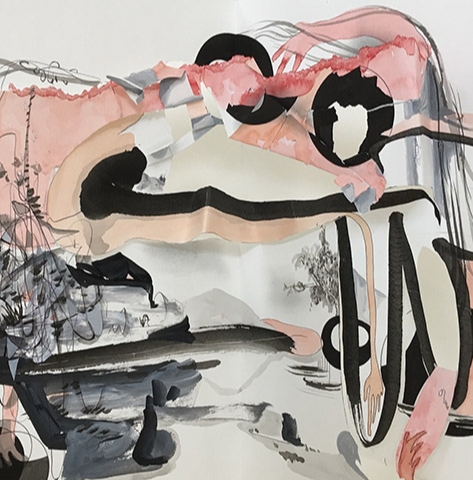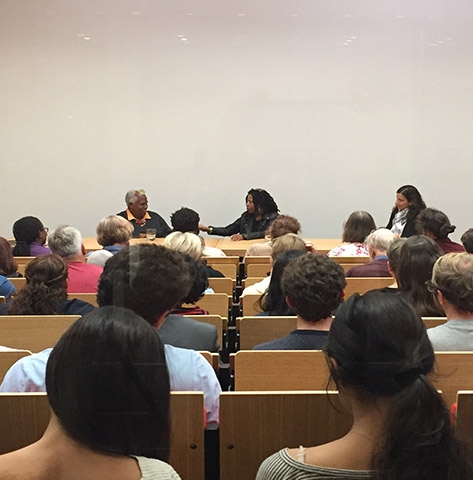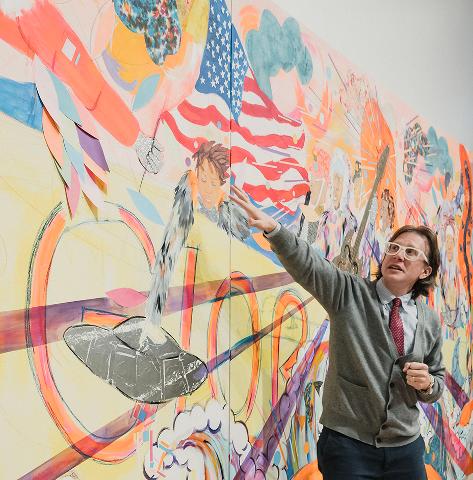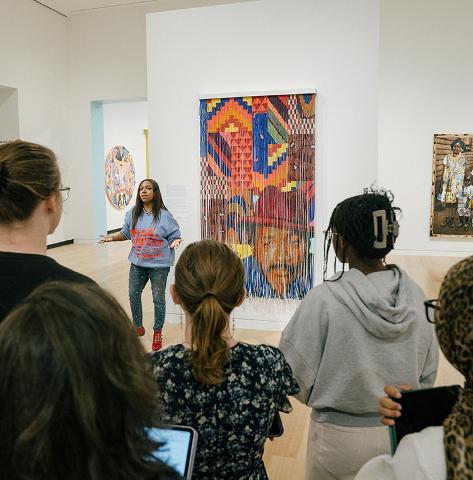Janelle Rodriguez Photography
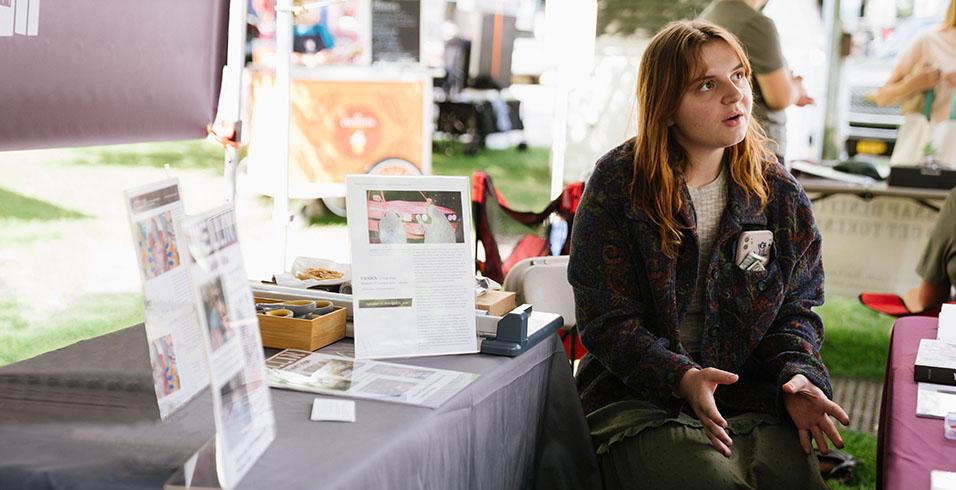
September 29, 2025
Curatorial Work from an Intern’s Point of View
Alexander Jarman, Assistant Curator of Exhibitions and Academic Outreach, in conversation with Hamilton College student Anna Totilca, Class of 2027
A few weeks ago, the Wellin was full of out-of-town visitors as well as many members of our Hamilton College community to celebrate the opening of our two latest exhibitions, Jamea Richmond-Edwards: Another World and Yet the Same and EXODUS. It was a time for celebration and also a time for reflection—a chance to think about how many people contribute their talents in order to create the dynamic shows we present in our gallery. With that in mind, I wanted to take a moment to highlight the experience of someone I worked closely with in the months leading up to the exhibition openings, our student intern Anna Totilca, Class of 2027. The following is an excerpt from an interview I conducted with Anna after her internship concluded, in which we discussed our campus, museum careers, and the work of Jamea Richmond-Edwards. I hope you enjoy it!
Alexander: Hamilton College is a bustling, energetic campus during the academic year, but the vast majority of our 2,000 undergraduate students leave our community for the entire summer break. This past summer however, you opted to stay on campus for an internship at the Wellin Museum, so I’m just curious, what is the student experience like in the summer time?
Anna: There is a bit of a struggle to transition from a “school schedule” to a very regulated “work schedule.” On one hand, a 9-5 job provides a more focused path for your day-to-day. I mean the school year is stressful but you can kind of do it on your own schedule, and then when you’re suddenly thrust into a more regimented summer, your brain is like what’s going on, you know? But having a dedicated space to focus at the museum on a single project was also a nice change of pace. There are also some really great summer events for summer staff like community lunches, which I appreciated because all your other meals require a lot of grocery shopping and cooking for yourself! When my friends ask me about the campus in the summer, I actually compare it to deep winter, when you just don’t see that many people outside. Even though there was nice weather this summer, it was just so noticeable that there weren’t a bunch of people walking around and talking out on the grass late into the evening.
Alexander: You were assigned a pretty large research project for your internship, but also were introduced to many different aspects of museum work. What were some of the best things you learned about working in museums?
Anna: I really like working with different departments, and I especially loved working with the registrar and logging items in their database. It made my experience fun, because some people’s internships are so regimented that you have to stick to a very narrow task, like sorting someone’s files! I loved having a really big research project about the artists in the new exhibitions—everyone interprets pieces of art or artists’ careers differently, and so I went down a lot of rabbit holes finding what authors and critics said about certain artworks. I was grateful to have the space to take those “deep dives.” I learned how complex something like “inspiration” can be for any one artist, and how difficult it can be to summarize and quantify an entire artist’s work and their points of inspiration into one paragraph. If I were ever to go into curation in the future, I’ll have to get a lot better at synthesizing. You have to think a lot about what kind of information will be most helpful for specific groups, like our docents here at the Wellin. There was no way everything I was finding, like the research I did in Hamilton’s Special Collections archive related to [musical composer] Sun Ra, was going to make it into my final writings.
Alexander: One special aspect of your research about artist Jamea Richmond-Edwards is that you two share a common hometown of Detroit, Michigan. After thinking so much about that place all summer, I’m wondering what you love in particular about Detroit.
Anna: I really love demystifying Detroit for people. They usually think it’s a violent place where you’ll get mugged at any moment. Yes, there are places you probably shouldn’t walk alone like any other American city, but I love showing people the culture of Detroit. All the photos of Detroit seem to focus on the parts that are crumbling, but I love talking to people who have a negative opinion of that place and then telling them about my experiences going to the Detroit Institute of Arts, which is in the museum district. You can just hop from museum to museum and see so much art, culture, and history for a very affordable price. There is so much influential music that came out of the city, like Motown. I love all the markets, free concerts, and public art there too. And especially the public art by Hubert Massey, who is in the EXODUS exhibition! There is a moment in the Wellin’s video about Jamea’s art where she quotes her friend Sheefy McFly who says, “Detroit’s biggest export isn’t cars, it’s culture.” I definitely agree with that, when I’m there I don’t see the cars as much as I see the culture all around me.
Alexander: You pored over Jamea Richmond-Edwards’s work as much as anybody else during your internship. What was the most surprising thing you learned about her art and career?
Anna: I loved learning about how she thinks, how she is so intuitive and how she draws from so many different inspirations. And she is not the same artist she was five or ten years ago, so in a way it was almost like I was dealing with multiple artists when I was researching her work, you see how she has grown artistically. She is very intentional and yet she doesn’t sketch or preplan her compositions specifically. Her pieces are like a beautiful stream of consciousness, she’s like a writer who works out her thoughts on the canvas.
Alexander: You also researched the artists exhibiting in EXODUS, a show curated by Jamea Richmond-Edwards and highlighting the ways in which her own community of fellow artists have supported her and each other. As an art student yourself, how does the concept of the EXODUS show resonate with you? Who are the people that support your artistic vision now?
Anna: This show makes me think about art in terms of relationships rather than “success.” I feel like most parents are nervous when their child is an art major, they think you’re going to end up living under a bridge. How can you make a career out of art? How do you commodify your work? Seeing Jamea’s show next to another show of the folks that supported her, it motivates me to continue to build my own connections and not let go of my own dream of becoming an artist. I’m glad to know that she was part of an artist collective, because I feel like the world is getting more isolated and I think that type of approach might inspire people to reach out to their peers more. This just gives me a lot of hope overall. My junior seminar cohort is my support network now. Critique and discussion are a big part of the program and I think we are going to end up being a very tightly knit group that continues to support each other.


